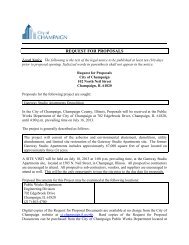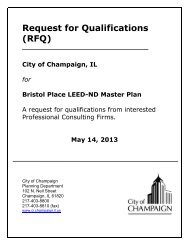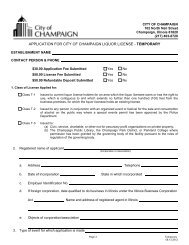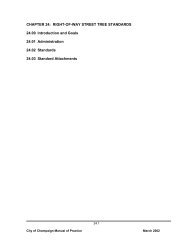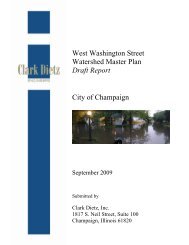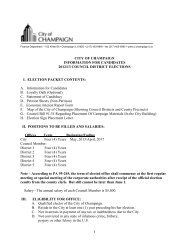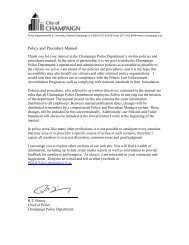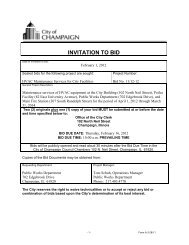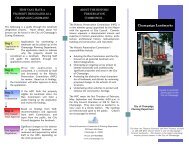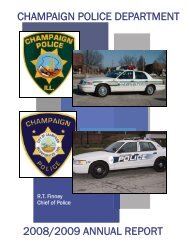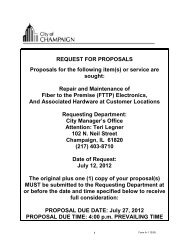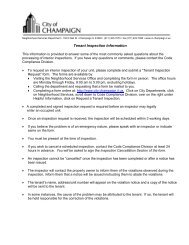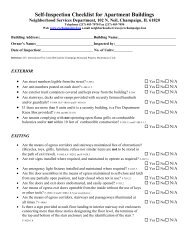2010-2014 Consolidated Plan - City of Champaign
2010-2014 Consolidated Plan - City of Champaign
2010-2014 Consolidated Plan - City of Champaign
Create successful ePaper yourself
Turn your PDF publications into a flip-book with our unique Google optimized e-Paper software.
Loan Denial Rates by Race and Income<strong>City</strong>wide data is also available to evaluate lending patterns by the race and income <strong>of</strong> loan applicants.Across all income categories in 2001, minority households experienced higher denial rates for privatesector housing loans as compared to whites. This trend is consistent across all private loan categoriesanalyzed: home purchase, home improvement, and refinance loans. Government loans were the oneexception (i.e. FHA, VA, etc). The <strong>City</strong> <strong>of</strong> <strong>Champaign</strong>’s Analysis <strong>of</strong> Impediments to Fair Housing (2007)report reviewed 2005 HMDA data and found similar results. For purposes <strong>of</strong> this analysis, “minorityhouseholds” include households with races and ethnicities other than “white.” Although this informationis not available by planning area, it can be assumed that planning areas with high concentrations <strong>of</strong>minority households would also have higher loan denial rates as a result <strong>of</strong> this trend. Because nonwhitehouseholds are less able to access private sector housing financing for home purchases and homeimprovements, public sector programs may be necessary to address this disparity.HOUSING MARKET FOR SPECIAL POPULATIONSHousing Available to Serve Persons with Disabilities & HIV/AIDSHousing for persons with physical and developmental disabilities consists <strong>of</strong> several assisted, non-assistedand public housing complexes, as well single-family units. The need for supportive as well as nonsupportivehousing is significant for the disabled population in <strong>Champaign</strong>. The <strong>City</strong> <strong>of</strong> <strong>Champaign</strong> hasimplemented visitability standards for all new single family housing constructed under a <strong>Consolidated</strong> <strong>Plan</strong>initiative. Visitability standards were implemented to integrate accessible and visitable units throughoutthe community, and to create more housing choices for disabled persons.The <strong>City</strong> <strong>of</strong> <strong>Champaign</strong> <strong>of</strong>fers a home accessibility retr<strong>of</strong>it program, which enables low- to moderateincomeresidents to rehabilitate their homes to make them accessible for disabled persons. In addition,the <strong>City</strong> also considers visitability and accessibility improvements to be eligible under other rehabilitationprograms. During the last four years, 32 households received assistance through this program. Another50 households are estimated to require this assistance over the next five years.There are a number <strong>of</strong> group home facilities available for persons with varying types <strong>of</strong> disabilities. TheMental Health Center <strong>of</strong> <strong>Champaign</strong> County and Developmental Services Center (DSC) provide grouphome living, case management, counseling and family support services, as well as developmental andvocational training to people with developmental disabilities in <strong>Champaign</strong> County. Both agenciesoperate Community Integrated Living arrangement group homes, each serving 6 to 8 individuals in afamily style setting. DSC operates CU Independence Apartments a HUD subsidized unit, consisting <strong>of</strong> 24apartments for persons with developmental disabilities.<strong>Champaign</strong> House is operated by Greater Community AIDS Project and it provides housing for fivepersons with HIV/AIDS and their families. It is the primary supportive housing facility in this area forpersons affected with HIV/AIDS. <strong>Champaign</strong> House provides residential social services and transitionalhousing for individuals with HIV who are at or below poverty level. From the homeless survey conductedby the Urbana-<strong>Champaign</strong> Continuum <strong>of</strong> Care, it is estimated that another 10 units <strong>of</strong> supportive housingfor persons with HIV/AIDS will be needed over the next five years.Assisted Housing InventoryThe Housing Authority <strong>of</strong> <strong>Champaign</strong> County (HACC) operates 443 public housing units in <strong>Champaign</strong>County, <strong>of</strong> which 287 are in the <strong>City</strong> <strong>of</strong> <strong>Champaign</strong>. The HACC administers 75 SRO and special purposeSection 8 vouchers and 1,340 regular Section 8 vouchers in the county. As <strong>of</strong> the <strong>2010</strong> Annual Agency<strong>Plan</strong>, there were 1,528 households on the waiting list for Section 8 and 97 households on the waiting list18 Housing Market Analysis



